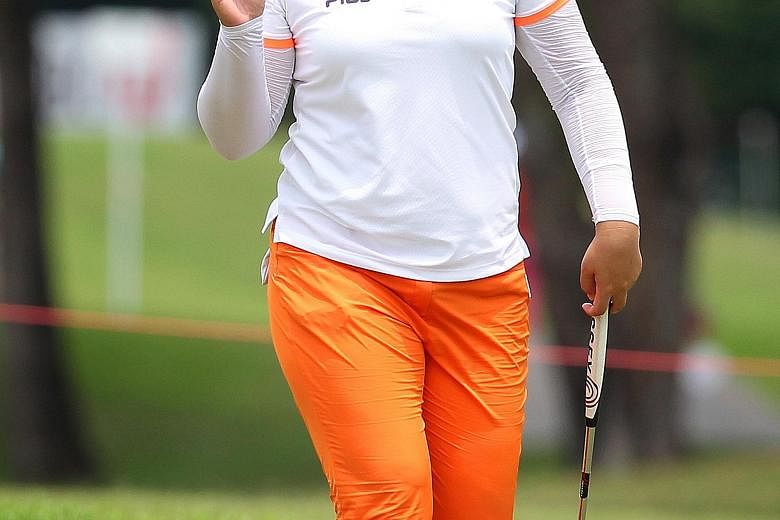SEOUL • Other golfers beware.
With an ultra-competitive domestic Tour and a seemingly limitless supply of young, talented players willing to sacrifice everything for success, South Korea's dominance of world women's golf is not going away - and, if anything, it could get even stronger.
For years now, rivals have watched in wonder as a succession of South Korean players with immaculate techniques and nerves of steel lifted trophy after trophy, including five of the last 10 Majors.
Among the world's current top 10, six are South Korean, including No. 2 Park In Bee. Top-ranked Lydia Ko is a New Zealander born in that Asian nation.
Nine of the top 20 are also South Korean. Out of the 31 LPGA events contested so far this year, South Korean golfers have won 15 - two of them playing in their rookie season.
Theories abound as to why they dominate and include vague mumblings about "sensitive fingers".
It is a real or imagined physical trait that is also cited when discussing their success in archery.
More considered opinions cite a combination of cultural forces - a strong work ethic, parental support and a grinding education system that encourages the sort of repetitive, focused effort that suits the quest for golfing perfection.
But Korean LPGA executive vice- chairman Kang Choon Ja believes the real answer lies in a top-quality domestic Tour, which allows players to begin their international careers almost fully formed.
The prominence on the international stage is down to "the continued emergence of star players... through an extremely competitive domestic Tour structure that gives them experience of top-class tournament play," Kang said.
South Korea's rise as a golfing power dates from the 1998 US Open victory of Pak Se Ri - then 20 years old and in her rookie LPGA season.
She was the first Korean - indeed, the first Asian - to win the oldest women's Major and became the poster girl for a golfing boom in her native country.
Pak won Rookie of the Year in 1998 and seven other countrywomen have emulated her since.
The same number has also won US Open titles, including this year's victor Chun In Gee.
"Their work ethic, fundamentals, techniques are amazing," US women's golf legend Juli Inkster told reporters when she was in South Korea for the recent LPGA KEB Hana Bank Championship.
"What I love about Korea is the way the people, the players, they have so much respect for women's golf," she noted.
From just a few hundred in the 1990s, the number of full professionals, semi-pros and teaching pros has exploded to more than 2,000. The KLPGA has developed a three-tier tour system to try to meet the demand.
The Jump Tour has 16 events for fledgling players while the Dream Tour, for more advanced competitors, boasts 20 tournaments.
There are 29 first-class events on the full-fledged KLPGA tour.
Total prize money for the latter now stands at 18.5 billion won (S$22.4 million), up from two billion won in 1996 and nearly twice the 10 billion won available on the local men's Tour.
"The lower-tier Tours are a great opportunity for players to improve their skill sets and get the early, practical experience of tournament play that will set them up for the future," Kang said.
The players coming through the system do not lack confidence.
"Top KLPGA players are good enough to lift an LGPA trophy any time," said Park Sung Hyun, a star in the making who has won three domestic Tour titles this year.
Like many players of her generation, she started early, picking up her first club at eight and embarking on a strenuous training programme backed by her parents.
"It was my mom who got me into it. At that time, Pak Se Ri was on TV a lot. So I really started out as one of the 'Se Ri kids'," said the 22-year-old. "I practised from dawn to dusk for up to eight hours almost every day."
Further back down the line are the likes of 13-year-old Sophia Lee.
She started in January but is already enrolled in a top after-school golf academy which puts her through a strenuous daily programme from 3 to 9.30pm.
"After golf practice, I work out a lot in the gym, especially on strengthening my core. It's a tough workout," the teenager said.
Such academies do not come cheap but parents are used to the idea of dedicating a whopping chunk of their income to extra tuition, whether it be evening cram schools or specialist training.
But the return on investment can be huge if their daughters break through into the big time.
"Women's golf is one of the most popular sports here in terms of fandom and corporate sponsorships," said veteran golf columnist Kim Maeng Ryung.
Players are starting earlier than ever and, with the right financial support, the training and facilities they can access is second to none.
"But then the competition to become just a regular KLPGA player is absolutely cut-throat," Kim said.
AGENCE FRANCE-PRESSE

